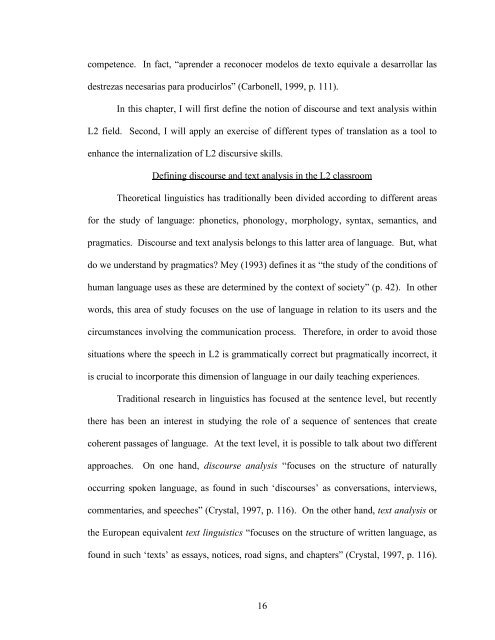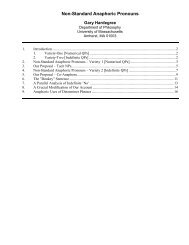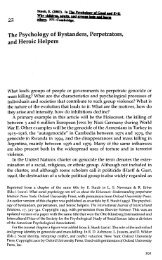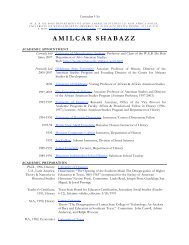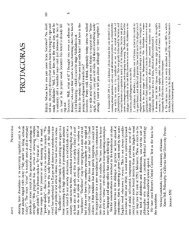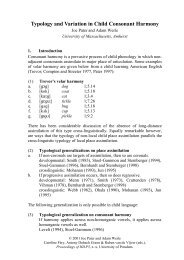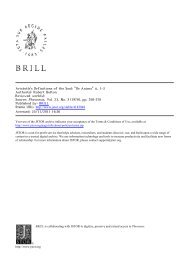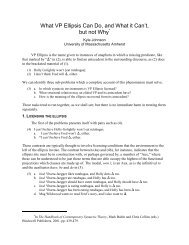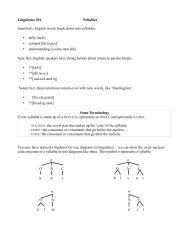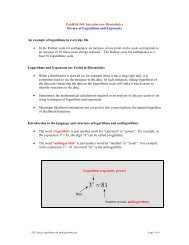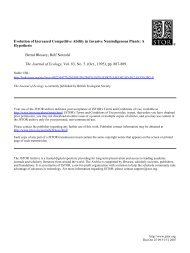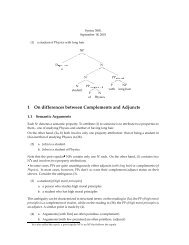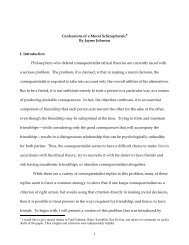rethinking translation in the second language classroom
rethinking translation in the second language classroom
rethinking translation in the second language classroom
Create successful ePaper yourself
Turn your PDF publications into a flip-book with our unique Google optimized e-Paper software.
competence. In fact, “aprender a reconocer modelos de texto equivale a desarrollar las<br />
destrezas necesarias para producirlos” (Carbonell, 1999, p. 111).<br />
In this chapter, I will first def<strong>in</strong>e <strong>the</strong> notion of discourse and text analysis with<strong>in</strong><br />
L2 field. Second, I will apply an exercise of different types of <strong>translation</strong> as a tool to<br />
enhance <strong>the</strong> <strong>in</strong>ternalization of L2 discursive skills.<br />
Def<strong>in</strong><strong>in</strong>g discourse and text analysis <strong>in</strong> <strong>the</strong> L2 <strong>classroom</strong><br />
Theoretical l<strong>in</strong>guistics has traditionally been divided accord<strong>in</strong>g to different areas<br />
for <strong>the</strong> study of <strong>language</strong>: phonetics, phonology, morphology, syntax, semantics, and<br />
pragmatics. Discourse and text analysis belongs to this latter area of <strong>language</strong>. But, what<br />
do we understand by pragmatics? Mey (1993) def<strong>in</strong>es it as “<strong>the</strong> study of <strong>the</strong> conditions of<br />
human <strong>language</strong> uses as <strong>the</strong>se are determ<strong>in</strong>ed by <strong>the</strong> context of society” (p. 42). In o<strong>the</strong>r<br />
words, this area of study focuses on <strong>the</strong> use of <strong>language</strong> <strong>in</strong> relation to its users and <strong>the</strong><br />
circumstances <strong>in</strong>volv<strong>in</strong>g <strong>the</strong> communication process. Therefore, <strong>in</strong> order to avoid those<br />
situations where <strong>the</strong> speech <strong>in</strong> L2 is grammatically correct but pragmatically <strong>in</strong>correct, it<br />
is crucial to <strong>in</strong>corporate this dimension of <strong>language</strong> <strong>in</strong> our daily teach<strong>in</strong>g experiences.<br />
Traditional research <strong>in</strong> l<strong>in</strong>guistics has focused at <strong>the</strong> sentence level, but recently<br />
<strong>the</strong>re has been an <strong>in</strong>terest <strong>in</strong> study<strong>in</strong>g <strong>the</strong> role of a sequence of sentences that create<br />
coherent passages of <strong>language</strong>. At <strong>the</strong> text level, it is possible to talk about two different<br />
approaches. On one hand, discourse analysis “focuses on <strong>the</strong> structure of naturally<br />
occurr<strong>in</strong>g spoken <strong>language</strong>, as found <strong>in</strong> such ‘discourses’ as conversations, <strong>in</strong>terviews,<br />
commentaries, and speeches” (Crystal, 1997, p. 116). On <strong>the</strong> o<strong>the</strong>r hand, text analysis or<br />
<strong>the</strong> European equivalent text l<strong>in</strong>guistics “focuses on <strong>the</strong> structure of written <strong>language</strong>, as<br />
found <strong>in</strong> such ‘texts’ as essays, notices, road signs, and chapters” (Crystal, 1997, p. 116).<br />
16


